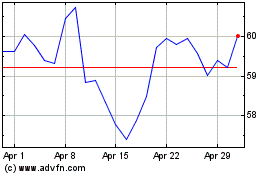Minnesota Power Replies to Comments on Its Generation Study
June 18 2012 - 8:42AM
Business Wire
Minnesota Power today filed additional comments with the
Minnesota Public Utilities Commission (MPUC) on its Baseload
Diversification Study (BDS) that was conducted as part of its long
range planning process, a process that will culminate with the
Company’s 2013 Integrated Resource Plan.
The BDS, filed in February, was the first of its kind in the
state and is one of multiple planning considerations the company is
using to determine what its generation mix will be in the coming
decades. The BDS provided a broad overview of cost and reliability
impacts of potential retirement, replacement or retrofitting of
Minnesota Power’s smaller coal-fueled units to meet changing
environmental standards.
“We value the comments and input received from various
stakeholders on the Study,” said Al Rudeck, vice president of
strategy and planning. “Community input is a critical part of our
integrated and dynamic planning process.”
A significant portion of stakeholder comments were about the
future of Minnesota Power’s coal fired generating plants, including
Laskin Energy Center in Hoyt Lakes, Minn. and Taconite Harbor
Energy Center in Schroeder, Minn. The company said in its comments
filed today that to shut down units without a thorough and
systematic analysis could put customers at unnecessary risk of
higher rates and potential service reliability impacts and have a
negative socio-economic effect on host communities.
The company acknowledged that while the BDS provided an advance
look at a small part of the company’s 2013 resource plan, it also
points to issues that require a deeper analysis to fully understand
impacts and make decisions in the best interests of northern
Minnesota’s electric customers. Weighing the decisions of
installing further environmental controls against closing down
units while factoring in the costs of replacing generation, future
fuel prices and increased industrial energy loads takes detailed
long-range planning.
“We’ve already decided that wind, water and wood renewables and
natural gas will play a greater role in our energy mix and already
have reduced some coal resources, but before we decide exactly what
further changes may look like, we need more insight than what was
provided by this Study,” Rudeck said. “Safety, reliability,
affordability and the availability of different types of electric
power generation are all important parts of that decision.”
Minnesota Power has taken significant action to improve the
environmental performance of its fleet; keeping pace with the
nation’s rapidly transforming energy landscape. The company’s
generation fleet was 95 percent coal-based in 2005, but by next
year the ratio will drop to 74 percent coal and 26 percent
non-coal, with a greater non-coal percentage projected to come.
Transitioning from fossil-fuel based energy to renewable energy is
a capital intensive endeavor. In recent years Minnesota Power has
invested about $500 million in wind energy, biomass and hydropower
improvements.
The company also noted its cost-competitive actions to reduce
carbon and other emissions, including the purchase of a 465-mile
direct current transmission line to move about 400 megawatts of
wind energy to its customers, and projects that have reduced
emissions of sulfur dioxide, nitrogen oxide and particulates, at
all of its coal-fired generating stations. These environmental
investments have resulted in a 70 percent reduction in generation
fleet emissions since 2005. Another major retrofit at the company’s
Boswell Unit 4 – a project unveiled since the completion of the BDS
– will bring the system wide emission reductions to an estimated 85
percent. Minnesota Power has developed award winning programs to
partner with customers to conserve energy, delivering 2.1 percent
conservation this past year, well ahead of the 1.5 percent state
requirement.
“Meeting the energy needs of our customers now and in the future
is far more complex than simply closing a facility and walking
away,” Rudeck said. “For decades coal has provided the most
reliable, safe and affordable electric power to our customers and
it will continue to be an important part of our energy mix, just as
electric power will continue to be one of the most important
services for our residential customers, for businesses and
industry, and for the quality of life of this region. There are no
shortcuts in making the best decisions in the best interest of our
customers.”
Minnesota Power plans to file its next integrated resource plan
in 2013. The plan will address Minnesota Power’s entire energy
supply picture as well as build on what was learned in the BDS,
including a cost analysis of environmental controls to meet the
evolving new EPA air regulations, including those just finalized in
December, and potential unit remissioning or closure impacts to
communities where the coal-fired units are located. Decisions will
have to be made against a backdrop of projected increased energy
demand in the region, fluid fuel prices, and pending environmental
regulations.
Minnesota Power, a division of ALLETE, Inc., supplies electric
service to 144,000 residents, 16 municipalities and some of the
largest industrial customers in the United States. For more
information visit www.mnpower.com.
The statements contained in this release and statements that
ALLETE may make orally in connection with this release that are not
historical facts, are forward-looking statements. Actual results
may differ materially from those projected in the forward-looking
statements. These forward-looking statements involve risks and
uncertainties and investors are directed to the risks discussed in
documents filed by ALLETE with the Securities and Exchange
Commission.
Allete (NYSE:ALE)
Historical Stock Chart
From Jun 2024 to Jul 2024

Allete (NYSE:ALE)
Historical Stock Chart
From Jul 2023 to Jul 2024
